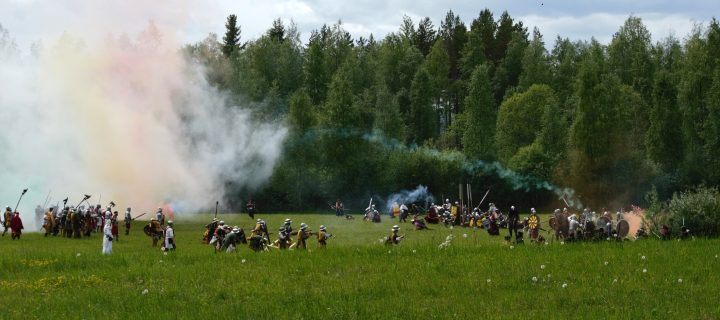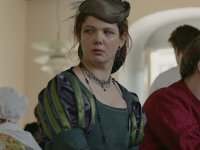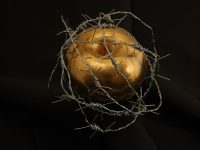Krigshjärta 7 was the latest addition to the Krigshjärta (Heart of War) campaign, a Swedish war larp campaign that has gained international recognition since its founding in 2006. The campaign uses a collectively developed renaissance low-fantasy fiction available online for public use. The main story follows the ongoing conflict between the capitalistic trade federation Gillet (The Guild) and the fascist-communist empire of Cordovien (Cordovia).
The setting of Krigshjärta 7 was a small incursion into the Cordovian homeland by Guild special forces as part of a war over a natural resource known as Cordovium, required to cure a viral disease that was spreading all over the world. The scenario took place in the mining areas of Cordovia, where this resource is extracted, and focused primarily on holding and extracting this resource instead of eliminating the enemy force. All players played soldiers or civilians in attachment to one of the armies, each with a main camp for immersion-style role-playing.
Both camps were separated from one another by a small game area used for combat, consisting of primarily wide open fields, a lake and some forested areas. At this game area three outposts and two minor bases were built and decorated to be used during the game as control points. The game attracted roughly 400 players and took place between Tuesday the 9th and Sunday the 14th of June 2015. Players were in-game around the clock between Wednesday lunch and Saturday afternoon.
Swedish War Larp 101
War larp in Sweden is not only widespread and grand, but a style that has rapidly grown in popularity during the last years. Where traditional Swedish fantasy larp generally avoids the international brand “Nordic larp”, major productions like Granland or Krigshjärta actively describes themselves as Nordic larp in order to attract international players. The style tries to uphold an immersionist tradition, while at the same time promoting gamistic elements like combat.
Swedish war-larping has many similarities to Swedish fantasy-larping, primarily a long tradition of historical design and craftsmanship mixed with a strong culture of DIY. Both personal costumes and shared equipment (like tents, furniture and banners) are amongst many players’ top priorities.
Because of this, Swedish fantasy-larping fields some of the highest-quality costumes and equipment available on the market today. Swedish war-larping is no different. At a Swedish war larp, the group is the organizational basis of the game. Groups create their own fiction and characters (though strictly within the bounds of the scenario) and are in charge of food, lodging and transportation as well as of all costumes and props. Because of this, most groups also play as a squad together. Most games have substantial demands on in-game tents and furniture being historically accurate, and generally do not offer an off-game camping site. Almost all games take place at locations in the wilderness. Organizers supply the overall scenario and fiction, the location as well as drinking water and sanitary solutions for all participants.
Location, Location, Location!
Traditionally, Swedish fantasy larp organizers look for a cheap location in order to save money, the result almost always being several logistical problems and a lot of gametime wasted taking care of easily solvable logistics like getting water or having to go very far to get to the bathroom. Sweden has also often had problems with large distances between the two camps, resulting in less action on the game area and long marching distances tiring the players. We wanted to change this. We rented a fantastic location with toilets and fresh water easily accessible all over the game area. A big lake alongside the entire area for in-game bathing, as well as off-game showers and electricity right by the camp. The area was a maximum of one square kilometer large, resulting in very short marching distances and the feeling that the enemy was always close by… Which they also were! We adapted the scenario accordingly, issuing a constant “hold the line”-order, allowing all squads to go into battle whenever they wanted – without having to wait for in-game orders from commanders.
The Rejuvenation of Swedish War Larp
Making Krigshjärta 7 we wanted to breathe new life into a scene that had been doing the same thing for ten years. We wanted to take a new look at the game design, so we did. To this end, the organisers recruited controversial game designer Hampus Ahlbom as well as the original founder of the campaign, Robin Berglund. The idea was to find a new approach to many of the common problems that had been plaguing Swedish war larps for years. We did.
The first thing we realized was that the entire game was heavily reliant on players of in-game officers on both sides successfully synchronizing the time and place for battles using (literally) medieval methods that failed most of the time. Instead, we created a system where the players were required to occupy different control points at scheduled times, earning points if they succeeded. We put a lot of energy into informing the players about this and thus managed to create several “naturally occurring” times and locations for those who wanted combat. It worked wonders. We had at least three times as much combat as ever before, something that we had always wanted. When the officers no longer had to worry about synchronizing battles, they could suddenly focus more on role-playing and upholding the immersion in camp. We wanted to use this, and we also wanted to make the players feel and think that the in-game world was bigger than only the larp area. So we started using NPCs and missions.
NPCs and Missions
Four to five times a day the game masters would send in a mission to the in-game officers, usually one mission per side. The objectives were very specific, and if the mission was successful, the team was awarded points. The missions would arrive in the form of a printed off-game document with some short fictional information plus the time, the place and the mission objective. The officers would then use that information to create an in-game order, adding all the fiction and roleplaying required to uphold the illusion. A squad would be dispatched, which was limited to a certain amount of soldiers and armor in order to ensure that they met a balanced resistance whenever possible. As most players participated in the game as part of a squad, the goal was that each squad at the game would get to experience at least one mission. Many had two.
The missions added an extra flavor to the game. This was partly because the players would almost always only encounter NPCs on the missions, thus adding to the illusion of there being a world outside the game area (new faces), but also because suddenly the game was more than just fighting the other side and hoping to win. The quests rarely had winning a battle as the objective – more often they were about rescuing someone, infiltrating a place or laying an ambush (and much more). The idea was to give the players a broader immersion into the life of a soldier. Because the missions were always created and performed by the game masters and NPCs we could guarantee a time and place to the players. As none of our NPCs participated in the actual game, but rather stayed in an off-game house when not performing missions – ready to act whenever required.
Winning the Game
For a long time Swedish fantasy-larping has frowned upon the concept of winning a larp, arguing that competitiveness creates friction and conflicts and that larp is an experience we create together.
This works well until you involve large gamistic elements, where the will to win is a fundamental driving factor. Krigshjärta has always had an outspoken policy that one team can win the game, and traditionally this has been done by winning the final battle on the last day, thus ignoring all battles up until then. We thought this to be unfair and cheap.
Instead, we created the system with control points to be controlled and missions to win. Players would generate points for their team (Gillet or Cordovien) and at the end of the game the winning team would be granted victory in the fiction. Winning a battle didn’t generate any points at all, thus making it possible to win all the battles but still lose the war. The result was a more fair competition, but it also made mastering not only combat but also logistics, endurance, speed and tactics necessary in order to win the game. The current score was updated several times a day throughout the game, and published at a discrete location in each camp. In the end the result was very close – with a victory for Cordovien.
Conclusion
One of the most important things to know is that this new, and somewhat controversial, game design was in no way mandatory for the players to use. We actually called it Krigshjärta Plus and presented it as an add-on to the traditional way of playing Krigshjärta. Players were free to use it (or not) as they pleased. That being said, the goal of the new game design was primarily three things:
- To improve the quality and quantity of battles.
- To solve off-game communication problems between the two sides.
- To give players more control over their in-game experience, while at the same time maintaining the illusion of a military hierarchy.
This makes the game design of Krigshjärta 7 different from many other game designs in the Nordic larp tradition, primarily because very little of it focused on improving roleplaying or character immersion. Instead, it was a game in the word’s more traditional meaning, with a clear set of rules for achieving victory, a scoreboard and a tactical scenario. By creating an in-game scenario with a constant in-game order (hold the line) we gave players the option of commandeering themselves into battle when they wished, without feeling that they betrayed the illusion by doing so. This was highly appreciated and saved many players a lot of downtime.
By creating a clear set of rules for achieving victory, we ensured that the game was not dependent on off-game communication between the officers of both sides in order to synchronize battles. This left these players free to instead create bonus content that the game was not dependent on, for example focusing on maintaining and improving the in-game illusion. This removed a lot of off-game responsibility from the officer players, which led to an improved experience for both them and those playing soldiers.
By using control points to generate points at specific times every day we managed to create a naturally occurring time and place for battle, so that those who wished to fight could do that without feeling that they were breaking the illusion. This made it possible for players to schedule their game, allowing them to plan festivities, heavy scenes or battles for themselves in good time. This allowed each player to have a broader playing style, being able to focus on different play during the game – without having the threat of an alarm constantly hanging over them.
The game design was a huge success and is already influencing future war games being created, both in Sweden and abroad.
Krigshjärta 7 (Heart of War 7)
Credits: Hampus Ahlbom, Robin Berglund, Peter Edgar and Maria Rodén.
Dates: June 9–14, 2015
Location: Kopparbo, Västmanlands län. Sweden.
Duration: 3.5 days in-game. 5 days with workshops.
Participants: 400
Participation Fee: €50, €70 or €100, depending on income.
Game Mechanics: Immersive camp game and gamistic wargame
Website: http://www.krigshjarta7.com/
This article was initially published in The Nordic Larp Yearbook 2015 published by Rollespilsakademiet and edited by Charles Bo Nielsen, Erik Sonne Georg, et al.
Cover photo: Battle ensues (play, Kalle Burbeck).






